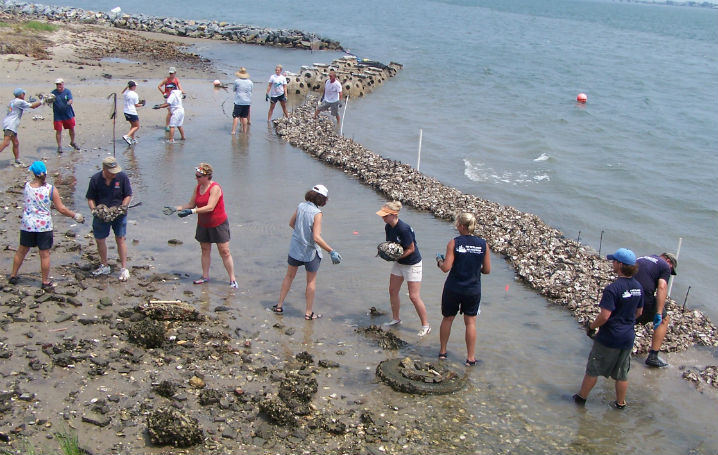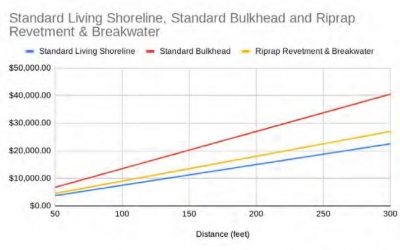
Typically, once a landowner learns about living shorelines, one of the first questions is “How much does it cost?”
Cost is the question that dominates the living shoreline conversation. The answer isn’t all that straightforward.
Supporter Spotlight
Baseline numbers presented at workshop recently held in Beaufort point to the standard living shoreline being the less expensive option to help reduce shoreline erosion.
But first, what is a living shoreline?
Lexia Weaver, coastal scientist and central regional manager with the North Carolina Coastal Federation, told Coastal Review Online that living shorelines are environmentally friendly shoreline stabilization techniques that help reduce shoreline erosion while protecting and restoring valuable salt marsh and oyster habitat at the same time. The Coastal Federation publishes Coastal Review Online.
Living shorelines have several benefits including reducing and dissipating wave energy rather than reflecting it, reducing scour of both the salt marsh wetlands and uplands, and incorporating natural elements such as salt marsh grasses and oysters, which naturally function to protect shorelines from erosion, and benefit fish and shellfish habitat. The salt marsh grasses and oysters also help to improve water quality through their filtering capabilities.
And, living shorelines can weather the storm. Weaver said that living shorelines fare better during hurricanes and storms than bulkheads or seawalls, are less expensive, and require little to no attention once established.
Supporter Spotlight
Depending on site conditions, there are a variety of methods and materials that are used to build living shorelines.
“Living shoreline construction typically involves the planting of salt marsh grasses alone, or in combination with a slightly offshore structure comprised of oyster shells or rock that is placed parallel to the shoreline to reduce wave energy,” Weaver said.
As for cost, Weaver said, that’s hard to determine because the cost varies depending on site conditions and materials and whether volunteers are used rather than paid contractors.
“In North Carolina, ballpark, I would say that living shorelines made with bags of recycled oyster shells are about $75 per foot and those made with granite rock are about $350 per foot. The cost of bulkheads also varies with conditions and typically ranges from $200-$450 per foot,” she said.

Those numbers are similar to what Joshua Merritt, field ecologist, and Grainger Coughtrey, forestry technician, with Carolina Silvics Inc. presented during the two-day Living Shoreline Tech Transfer workshop recently held in Beaufort, hosted by Restore America’s Estuaries and the Coastal Federation.
Established in 1999 as a forestry and natural resources contracting firm, Carolina Silvics has been working with the federation for 14 years on many of the conservation organization’s projects. In 2017, the combination of a slow season for Carolina Silvics and increased demand for living shorelines pushed the firm into the new business venture.
Carolina Silvics specializes in offshore sill and marsh toe revetments, Merritt said. Offshore sills consist of bags that are placed just off the shoreline to help rebuild eroded shorelines. Marsh toe revetments are bags placed up against marsh grass shoreline to protect the property from further damage.
Coughtrey explained that there have been challenges transitioning living shorelines into a business including securing materials, minimizing footprint and pricing must be affordable and appealing to the landowner while also allowing Carolina Silvics to make a profit.
“Shoreline pricing depends on how long it will take and how long the shoreline will be,” he said.
Merritt said that bulkheads usually start at about $135 per foot of length but actual prices paid are generally more expensive than that starting price. Bulkheads are often damaged during storms and repairs can be expensive. In addition, bulkheads direct wave energy toward neighbors’ properties, accelerating their shoreline erosion.
The starting price for bagged oyster shell living shorelines is $75 per foot. “We started living shorelines three years ago and, through two hurricanes, they have proved their durability after and during large storms with minor damage,” Merritt said.
Merritt added that the price will increase depending on what type of shoreline selected. “Offshore sills are generally more expensive than marsh-covered revetment and the degree of escarpment will affect the price of materials.”
Coughtrey said that there is some early-on maintenance required after the shoreline is built and a storm can affect the shoreline before it is fully established, but living shorelines have a proven track record. “We all know that storms are getting stronger, we’ve had huge hurricanes in the past year and we’ve had shorelines that have survived those,” he said.
Riprap revetments start at $90 per foot, Merritt explained. Concrete is cheaper to use but not as durable as granite, the preferred material, he said.
The cost of breakwaters starts at $90 per foot and these structures require a major permit under the Coastal Area Management Act. Breakwaters, usually made of stone and parallel to the shore but not connected, are usually designed by an engineer and are generally more expensive because of the amount of stone required.

Merritt said that Carolina Silvics worked with the federation during the past three years to learn about living shorelines, techniques, where to obtain materials, how to construct the bags and the best techniques to build a uniform and stable shoreline following the natural contours.
“The main goal for both organizations was to combine ideas to find the most environmental, practical and economical solution for each unique property,” he said.
Weaver said that the federation has been working with Carolina Silvics for more than a decade on coastal restoration projects.
“As forestry contractors, they initially worked with the federation to plant thousands of tree seedlings and salt marsh grasses at the federation’s 6,000-acre wetland restoration project at North River Farms in Carteret County,” she said. “In 2017, however, these types of projects began to unfortunately slow down for them and the federation then began to partner with the company to train their staff to design, permit and build living shorelines through hands-on training. This significantly increased the amount of living shorelines that the federation was able to build each year since then.”
Weaver said that as a result of this partnership and training, Carolina Silvics now offers living shoreline installation as one of the services they provide. “Today, they are one of only two contractors in the state that build living shorelines with bags of recycled oyster shells.”
Coughtrey explained that the steps to have a living shoreline built by Carolina Silvics begins with meeting the landowner to discuss objectives and options. Once it’s determined what project they’re going to build, then its determined whether a general or major CAMA permit is needed. They then look at property ownership information and determine property lines, as well as collect contact information for the neighbors to ask approval to begin the project.
Once the neighbors approve, Coughtrey said they start working on a project map and schematics to help the property owner apply for the permit as well as meet with officials to explain the project. Once the permit is in hand, they begin obtaining materials to build the living shoreline.
“There’s been some very positive permit changes in the last year for offshore sills,” he said, adding that these recent changes to the permitting process for sills in North Carolina have made it much quicker and easier to acquire a less cumbersome general permit.
“The requirements for this permit are a project map, written project plan and adjacent property owner approval,” he said. “These improvements help contractors and landowners because we can now just go in much faster and the turnaround is much quicker.”
Merritt said that the business is working to “decrease our initial cost so that living shorelines may be more affordable for all economic statuses. This is a very important thing the coast needs.”
Merritt and Coughtrey spoke during the two-day workshop as part of the presentation, “Engagement and changing attitudes – What makes people and sectors adopt living shorelines?”
Jeff Benoit, President of Restore America’s Estuaries, called the workshop a success.
“We brought together people from all across the U.S. and Canada to learn from not only experts in the field, but from each other as well,”Benoit said in an email. “The feedback has been very positive – we’re thrilled to offer such a cutting-edge workshop.”







